INTEROPERABILITY
The VAP is committed to interoperability. This means harmonising the framework conditions so that trains can run freely on European rail networks.
Swiss freight transport knows no borders. Many of our members are internationally active and regularly serve the EU area. To ensure that we can continue to provide you with this access to an interesting market potential in the future, we are involved in the international arena.
- The «International Union of Wagonkeepers» – UIP for short – pursues European freight transport policy. We at the VAP founded the UIP in 1950 and have been incorporating the Swiss perspective in Europe ever since.
- The «European Rail Freight Association» sums up its goal: «We deliver competition!». We are also closely associated with this organisation and provide its Vice-President.
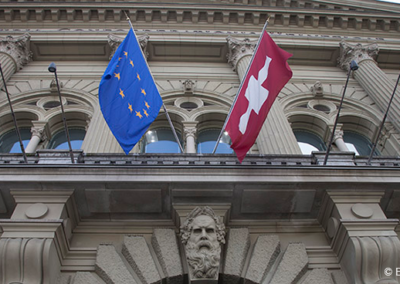
Bilaterals III: Switzerland must be involved in the future of rail freight transport
The Federal Council has given the go-ahead for the Bilateral Agreements IIIwith the definitive negotiating mandate. Negotiations on the so-called Bilaterals III began on 18 March 2024. We at the VAP support the efforts of the mandate in the area of overland transport. Switzerland must be able to help shape the far-reaching renewal of the rail freight transport system.
That’s what it’s all about:
- Stabilising Swiss-EU relations
- Mandate takes into account the fears of SBB and trade unions
- VAP welcomes continuation of the dialogue
- Joining forces in favour of rail as the mode of transport of the future
Stabilising Swiss-EU relations
At its meeting on 8 March 2024, the Federal Council adopted the mandate for negotiations with the European Union (EU). The negotiations on the comprehensive package are intended to stabilise and further develop bilateral relations between Switzerland and the European Union. They started on 18 March 2024. In its mandate, the Federal Council has adopted a number of recommendations, including market liberalisation in the electricity sector, the preservation of the cooperation model in the overland transport sector and the retention of customs tariffs in the agricultural sector. Other adopted recommendations relate to immigration, wage protection and institutional elements.
Mandate takes into account the fears of SBB and trade unions
In its «Report on the results of the consultation on the draft negotiating mandate between Switzerland and the European Union on the stabilisation and development of their relations», the Federal Council states that the model of SBB cooperation in international rail passenger transport remains possible, that Switzerland may continue to allocate train paths and that the rules for international passenger transport must not impair the Swiss quality of public rail transport. In its negotiating mandate, it also guarantees tariff integration, a synchronised timetable and a modal shift from road to rail. The regulatory dialogue in the financial sector between Switzerland and the EU will be resumed. In doing so, he dispels the unfounded fears of SBB and the trade unions of the «dark forces» of competition.
VAP welcomes resumption of dialogue
In our statement of 12 February 2024, we at the VAP welcome the fact that the government – in particular the Federal Office of Transport (FOT) and the Department of the Environment, Transport, Energy and Communications (DETEC) – is continuing its efforts to make progress on the key dossier for the rail sector in realistic stages despite the existing political deadlock between Switzerland and the EU. After all, market liberalisation offers Switzerland interesting opportunities such as guaranteed interoperability, greater innovative strength and higher efficiency. In this context, we also support the revision of the Railway Act and welcome the fact that there are already concrete proposals for amendments at ordinance level.
We consider the realisation of ERA membership for Switzerland following the successful negotiations to be the next milestone. The ERA has created expert status specifically for Switzerland. This means that Swiss experts can already participate in the ERA committees for the further development of the common specifications. In addition, Switzerland has been systematically adopting rules from the EU’s Interoperability Directive and Safety Directive for years. Overall, Switzerland has a great interest in securing sustainable access to the European railway sector as soon as possible through full ERA membership – not only to participate but also to have a say in decision-making.
We support the present negotiating mandate in the area of land transport. In our view, the market liberalisation in international passenger transport, which has not been implemented for years, is necessary and offers opportunities for interesting developments despite the restrictions imposed.The procedure for integrating the institutional elements into the sectoral agreements is justifiable based on our previous experience in the development of legislation with the involvement of Swiss experts.
Joining forces in favour of rail as the mode of transport of the future
Rail freight transport should regain market share thanks to innovation – that is what the EU wants and that is what Switzerland wants too.However, we need long-term strategies and strong investors to achieve this.Stability is the indispensable basis for international transport cooperation (see blog post «Stability as an indispensable basis for international transport cooperation»).The innovation for future rail freight transport with digitalisation and automation is currently being developed in the EU.Switzerland wants to participate and have a say in shaping this far-reaching renewal of the rail freight transport system.
This is only possible in an efficient and sustainable manner if political differences are resolved and there is sufficient clarity about future cooperation. This includes Switzerland rejoining the Horizon 2020 research and innovation programme, an update of the overland transport agreement between Switzerland and the EU and bilateral agreements on border operating routes with our neighbouring countries.
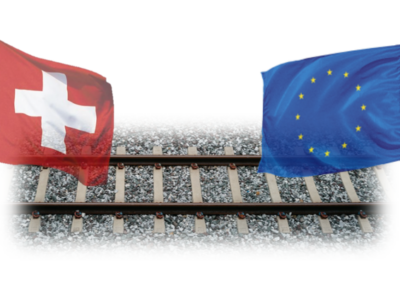
Stability as an indispensable basis for international transport cooperation
Once again, the status quo was saved in the Joint Committee on the Land Transport Agreement, despite the gloomy outlook. In 2024, the EU will once again grant Switzerland limited access to the ERA data platform OSS for one year. How long does Switzerland want to continue working with these dithering parties?
That’s the question:
- What is the aim of the Federal Office of Transport?
- Why is international cooperation important?
- Switzerland must move
- Stability is central to solving upcoming tasks
What is the Federal Office of Transport’s goal?
Trains should be able to travel across borders with as few obstacles as possible. The Swiss standard-gauge network forms a central part of the interoperable European rail network (Single European Railway Area). To make this possible, the FOT periodically harmonises the sovereign Swiss railway regulations with the current European rules of the Interoperability Directive and the Safety Directive. Switzerland should be able to act as an equal partner to the member states in the area of responsibility of the EU Transport Commission (DG MOVE). The overland transport agreement plays a central role in this bilateral cooperation. Ratified agreements create legal certainty and predictability.
Why is international cooperation important?
The EU wants to completely overhaul the existing national railway system and develop it into the strong mode of transport of the future. In future, modern trains are to run across borders on an efficient and standardised rail network without any obstacles. For this far-reaching transformation, rail operations must be redesigned from the ground up and new standardised systems with transparent interfaces must be developed and introduced. This can only be achieved with centralised coordination and guided cross-border cooperation. The 4th Railway Package, which came into force in 2019, forms the legal basis for this: as a European agency, ERA is now responsible for the technical design of standardised procedures and rules as well as for managing European authorisation procedures. For the necessary developments, the EU created new comprehensive organisations with «Europe’s Rail» as part of «Horizon» and provided them with considerable financial resources. Ministries, railway companies, associations and industry are called upon to actively participate in the ERJU’s numerous working groups, consisting of the System and Innovation Pillars, and to contribute their expertise to shaping the future European railway system. The topic of «DAK» is also an integral part of this organisation.
Switzerland must move forward
Over the past 25 years, Switzerland has adopted many elements from the newly organised EU railway world. Thanks to the proven equivalence, important steps towards integration into the European railway system have been achieved. The Federal Council’s decision to break off negotiations on an institutional agreement (InstA) has also meant that no substantial further development of the land transport agreement has been possible in the transport sector since 2021. Switzerland must now choose between isolation and cooperation.
Stability is key to solving upcoming tasks
The comprehensive transformation of the existing European railways, which are strongly national in character, into a modern, efficient overall transport system requires a joint, coordinated effort – going it alone could have serious consequences. Those who are part of it can participate and play an active role in shaping it.
Switzerland must now do its homework:
- Settle political differences with the EU
- Ensure permanent participation in the «Horizon 2020» research programme
- Update the EU-CH land transport agreement
- Implement the railway package market part (market liberalisation at least in international passenger transport)
- Complete rail package (adapt EBV, ERA membership, recognise ERA authorisations, regulate ERA competences)
- Reactivate bilateral agreements on cross-border routes
Transport and logistics are transnational. The planned migration to digitalisation and automation of the railways requires a willingness to make far-reaching changes on the one hand and major investments on the other. Both will only be possible in an efficient and sustainable manner if there is sufficient clarity about future cooperation.

Marco Rosso: «Collaborative innovation can contribute to the quality of life and function profitably at the same time.»
Marco Rosso is Chairman of the Board of Directors of Cargo sous terrain AG (CST). In an interview with the VAP, he talks about interoperability, non-discrimination on the last mile and the logistics of the future. And about how collaborative innovation can contribute to the quality of life of people in Switzerland and function profitably at the same time.
VAP: Mr Rosso, how do you see the relationship between rail freight and CST in the future?
Marco Rosso: Rail and CST are two systems that complement each other. CST cooperates with all modes of transport to jointly absorb the predicted freight traffic growth of over 30% by 2050 in an innovative, sustainable way. Because CST is not suitable for all transports, the company supports the business models of rail, road hauliers and other logistics players with new technology and digitalisation. Only with cooperation (within the framework of competition rules) can interoperability be guaranteed among the most diverse modes of transport and transport companies. Therefore, CST plans to connect to rail, road, ship, air freight and other systems. At the CST hubs, there will be multimodal connections, in particular also a rail connection. In the construction phase, starting as early as 2026 and continuing until 2045, CST will use rail transport to the tune of 2,000 goods trains per year and thus become an important rail customer.
Shouldn’t the state create the infrastructure and the operation in the tunnels, as well as the operation of the terminals and the last/first mile would then be free and subject to competition?
CST is a system that only works as a whole because all processes are controlled end-to-end. This is the only way to ensure that the general cargo reaches its destination on time and reliably. For this reason, the system must be managed from a single source and at the same time be connectable to all partner platforms. CST has been planned and conceived as a private-sector project from the very beginning. With this financing concept, it is possible and important to move forward quickly without straining the funds in the federal budget. The investors also include important future customers. They help to develop the system in line with the market. The Confederation has recognised that it would not be expedient to act as a creator itself, but to limit itself to the legal framework. With carefully prepared business plans, competitive prices and the broad investor base that supports the project, CST shows that innovation in freight transport contributes to the quality of life in cities and rural areas and can function profitably at the same time.
Where do you see the biggest challenges in your project?
Such a comprehensive project presents many challenges, for example in planning, legal, environmental, financial and political terms. What distinguishes CST is the model of collaborative innovation – with the inclusion of all stakeholders. The project approaches the challenges pragmatically in stages.
How do you design a non-discriminatory first/last mile?
Our system is planned to be non-discriminatory from the start anyway, without the law requiring it. The following applies throughout: everyone has access to the system with the same price for the same service. But we go even further, for example, by developing CST’s city logistics in a collaborative partnership and are open to any cooperation with smaller as well as larger partners, including the railways and the post office. Here, too, our principle is collaborative innovation, which we live by every day.
What is the greatest benefit or motivation of CST for the Swiss population?
The most important effect of CST will be to increase the quality of life for all inhabitants of Switzerland. By showing a way how the logistics of the future can look sustainable, how heavy traffic on the road can be moved away by bundling and pre-sorting in tunnels for all shippers, or how a traffic jam can be avoided for the supply of goods, how to get the best out of the available resources in terms of CO2 emissions, noise, etc. The precious space on the surface should primarily belong to the population. CST favours the expansion of infrastructure as well as renewable energies in Switzerland. CST is a privately financed driver of innovation for the benefit of the Swiss economy and for quality of life in cities and villages by guaranteeing security of supply and thus increasing prosperity in Switzerland.
Are there any points that you think we should still let our members know about?
There are decisive decisions and discussions ahead, especially against the background of the political debates on freight transport. We are firmly convinced that with an entrepreneurial attitude we can make an effective contribution to maintaining Switzerland in the 21st century as an excellent business location with a high quality of life, also for future generations. We participate in this work with enthusiasm and commitment.
Mr Rosso, thank you very much for the interview.
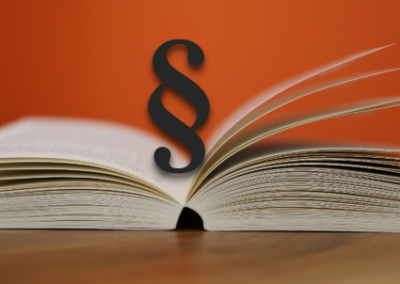
REVISION OF THE RAILWAY ACT: FULL EFFECT MAY NOT MATERIALISE
On 12 September 2023, the National Council approved the revision of the Railways Act (EBG), following its unanimous approval by the Council of States in the 2023 summer session. However, the revision of the Railways Act cannot be fully implemented until the 4th EU railway package is included in the land transport agreement or the transitional solution with the EU is extended. Inefficiencies could therefore remain.
That’s the point:
- What has happened so far
- Switzerland has adopted three EU railway packages
- Revised EBG creates equivalent conditions
- Ordinances must also be adapted
- Inclusion of the 4th EU railway package in the Land Transport Agreement necessary
What has happened so far
The 4th EU railway package has been in force since 16 June 2019 and the EU Railway Agency (ERA) is now responsible for issuing uniform safety certificates and approvals for rolling stock for cross-border traffic. In the 2023 summer session, the Council of States approved its committee’s request to amend the Railways Act (implementation of the technical pillar of the 4th EU railway package).
The 4th EU railway package contains three key elements:
- The applicable regulations are to be systematically harmonised in all participating countries. This is achieved through institutionalised entry into force procedures for the technical specifications for interoperability, TSIs and their updates. This means that TSIs published by the EU Commission are now directly valid in all countries; national implementation processes are no longer required.
- ERA monitors the removal of obsolete national regulations by the responsible national supervisory authorities.
- ERA now coordinates the authorisation procedures and issues uniform, cross-border operating licences.
ERA operates the online vehicle authorisation portal “One Stop Shop”. It works closely with the national supervisory authorities when checking authorisation dossiers. Today, an application for authorisation can be made and the corresponding dossier submitted in ERA’s “One Stop Shop”. The ERA examines the dossier in consultation with the national supervisory authorities involved and issues an operating licence that is directly valid in all the countries applied for.
Switzerland has adopted three EU railway packages
Switzerland has adopted the relevant technical provisions of the three EU railway packages as part of the land transport agreement with the EU. It already sits as an observer on the relevant committees for the ongoing development of interoperability and co-operates with the ERA. It has not yet been possible to join the ERA.
Revised EBG creates equivalent conditions
The technical pillar of the 4th EU railway package includes the revision of the requirements for interoperability (Directive 2016/797) and railway safety (Directive 2016/798). It also includes the further development of the ERA into an EU supervisory authority with the One Stop Shop for standardised procedures (see blog article “Switzerland faces isolation in international rail transport”). The revision of the Railways Act lays the foundations for implementing the technical pillar of the 4th railway package. Accordingly, all interoperable Swiss railways are to be subject to the same conditions as EU member states and access to the simplified authorisation procedure is to be opened up via ERA.
Ordinances also need to be amended
On the basis of the amendments to the EBG, the FOT can establish the necessary conformity with the EU directives in a second step at ordinance level. It has therefore already prepared the corresponding draft amendments to the ordinances and had them reviewed by the EU Commission – with a favourable result. Switzerland has thus independently created the basis for the equivalence of its legislation with that of the EU.
Inclusion of the 4th EU railway package in the land transport agreement necessary
With the implemented revision of the EBG, Switzerland has gained valuable time. After all, it usually takes several years for a revision of the law to come into force. In this case, the national legal framework is already in place. However, the inclusion of the technical pillar of the 4th EU railway package in the Land Transport Agreement and accession to the ERA are necessary for it to take full effect. Neither is foreseeable for the time being in the context of the faltering negotiations between the EU and Switzerland. The EU requires an agreement on the framework agreement and the opening of passenger transport in Switzerland (part of the 3rd EU railway package). The latter has so far failed to materialise; all attempts by the FOT to make concessions by softening the market partitioning by Switzerland have so far been unsuccessful.
Full interoperability and a fundamental simplification of authorisation procedures reduce administrative and operational costs. This is fundamental for safe and competitive rail (freight) transport and thus for a successful modal shift.
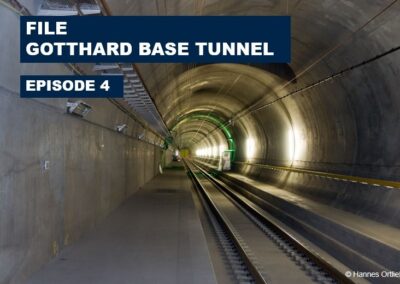
Gotthard Base Tunnel (#4): Safety-critical components of freight wagons
The publicly published information on the freight train derailment in the Gotthard Base Tunnel indicates a broken wheel on the derailed train. Overloading or material defects are under consideration as possible causes of the failure. What actually happened remains a matter for the ongoing investigations of the Swiss Transportation Safety Investigation Board (Sust).
Topics discussed:
- How are safety-critical components manufactured?
- How are they approved and put into operation?
- How are they maintained?
- What significance does monitoring have in daily operations?
- Which monitoring possibilities exist?
- Uniform rules enable safe cooperation between the actors
- Outlook for digital automatic coupling (DAC)
How are safety-critical components manufactured?
Safety-relevant and safety-critical components such as wheel pans are designed so as to perform their task over the planned period of use under the prevailing conditions of operation and use and thereby to ensure safe travel. The manufacturing firms make use of internationally recognised standards to accomplish this:
- Technical Specifications for Interoperability (TSI) establish fundamental requirements.
- European Standards (EN) define the specific properties.
- Manufacturers employ harmonised and standardised safety methods for development and testing.
- Standardised safety verifications and assessments document the safety and usability.
The international experiences from incidents and accidents continuously enter into the development of the standards and TSI.
How are they approved and put into operation?
Bringing safety-critical components onto the market requires an internationally standardised approval from the European Agency for Railways (ERA) or a national safety authority. This consists of:
- Type approvals for components or vehicles
- Conformity verifications for identical serial parts or vehicles
- CE mark (Conformité Européenne) for a component that satisfies the applicable EU directives
- Operating authorisation for a vehicle in compliance with the rules
The certification that components were manufactured according to the requirements of standards and TSI is issued by so-called “notified bodies”, in other words state-authorised agencies. These inspect and evaluate whether the manufactured products conform to the rules.
How are they maintained?
The manufacturer is obliged to define and publish the applicable maintenance requirements for all components or vehicles. Wagon keepers must implement these manufacturer requirements in accordance with the conditions of use. They appoint certified entities in charge of maintenance (ECMs) for their rolling stock. The latter in turn establish maintenance requirements for the vehicles assigned to them in consideration of their own knowledge and industry expertise. They also plan regular work, carry it out and document the results. Every wagon approved for operation must be registered in an official vehicle registry, including the name of the wagon keeper and the ECM.
What significance does monitoring have in daily operations?
The railway undertakings (RUs) are responsible for the safe travel, preparation, dispatching and other safety aspects of their trains. They define the inspections and tests for ensuring that every trip can be completed safely. To determine this operational suitability, trained employees carry out defined visual inspections before departure. This extremely demanding work takes place at all times of day and in all weather. During the train dispatching and the associated inspections and tests, safety-critical components are also afforded special attention.
Which monitoring possibilities exist?
The wagon keepers are responsible for the proper maintenance of their vehicles. Safety-relevant and safety-critical components are regularly inspected, such as with ultrasound measurements. Safety-critical components are subject not only to strict inspections but also special obligations with regard to labelling, maintenance and traceability of the measures. The RUs can demand wagon-specific information from the wagon keepers.
On the Swiss standard gauge network, the infrastructure operators currently maintain over 250 wayside train monitoring systems. These monitor every vehicle as it passes by for irregularities and can trigger alarms in the event of unacceptable deviations. In this case, the respective train is immediately stopped and inspected.
Uniform rules enable safe cooperation between the actors
A variety of different companies all work together in railway operations. Every actor must be able to depend on the reliability of the others at the points where they interface together. Their tasks and responsibilities are clearly and uniformly regulated at the international level. Harmonised regulations for manufacture, operation and maintenance ensure safe rail transport (for more on the regulations governing the international cooperation, check back on this blog again soon).
Outlook for digital automatic coupling (DAC)
Besides implementation of the applicable requirements by every actor participating in rail transport, new technologies are now coming to the fore. Automation and digitalisation can do more than simply make operating processes more efficient. They also open up new opportunities for operational monitoring of safety-relevant and safety-critical components in freight trains. The ongoing digital recording of the condition of these components offers an attractive opportunity to the responsible parties. By digitally tracking processes of wear and ageing processes on each individual vehicle, it is possible to efficiently plan maintenance work according to the actual needs. Faulty components can be identified and replaced before a total failure. If a component failure occurs during travel, this can immediately trigger an alarm.
To make use of this innovation in freight transport, the wagons require sensor systems, electrical energy and data communication with the train driver, the systems of the wagon keepers and the ECMs. These prerequisites will be met with the planned Europe-wide introduction of DAC (see the blog post “Data ecosystems: Sharing data to double its added value”). In this way, automation and digitalisation are transforming conventional rail freight operations into an intelligent, efficient, resilient and safe mode of transport.
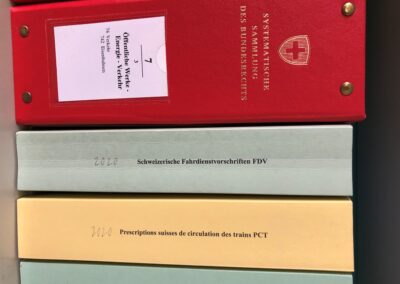
Driving service regulations: Please simplify and harmonise internationally
The Federal Office of Transport (FOT) is further developing the Swiss Driving Service Regulations (FDV2024) as part of the 2024 amendment cycle. Systematic changes are central. Here is a statement from the perspective of the shipping industry.
This is what it’s all about:
- Further development of the driving service regulations from 2024 in force
- Systemic simplification for railway employees required
- Consistent application of the TSI OPE additionally increases interoperability
- Railway industry should take responsibility for the rules on driving services
- VAP wants more entrepreneurial leeway for siding operators
For more than 20 years, uniform train service regulations have been in force in Switzerland, which are binding for all railway undertakings. They are essential for railway operations, as they define safety-relevant activities and cooperation measures and specify the tasks, competences and responsibilities of all those involved in railway operations. The FOT works closely with the railway industry to further develop the driving service regulations and update them every four years. This amendment cycle makes sense, as it takes into account both the daily experiences from operations and the technical developments in the railway industry. However, it also has negative side effects: For example, the TSO have grown into a jungle of regulations that is difficult to keep track of and that urgently needs to be streamlined and aligned with the interoperability regulations. The responsible companies must be granted more entrepreneurial freedom. The current revision is scheduled to come into force on 1 July 2024[1]
Amendment cycle 2024 with important sub-projects
We at the VAP welcome the systematic further developments of the driving service regulations proposed by the FOT in the conceptual sub-projects (cf. Figure 1). We also suggest that the fundamental innovations be implemented consistently and quickly.
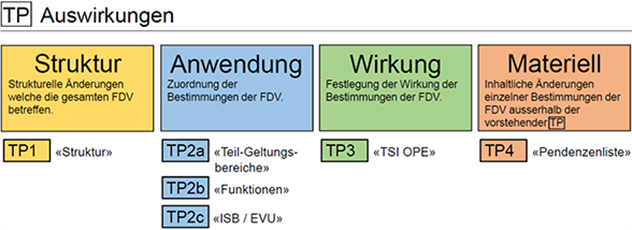
- With sub-project 1 “STRUCTURE”, the FOT wants to systematically structure the driving service regulations in order to make them more comprehensible and uniform for users. The full implementation of this unification will require several rounds of amendments. It usually makes sense to combine structural harmonisation with material adjustments.
- With sub-projects 2a, 2b and 2c “Application”, the FOT aims to create the conditions for a systematic digital use of the driving service regulations. Each individual regulation is assigned to a scope of application or an option. It is now specified who performs which function. As soon as this sub-project is realised, regulations can be clearly filtered according to areas of application and assigned to functions. This will massively increase efficiency in the creation and in all applications of regulations, as it allows for digital usage options.
- Within the framework of sub-project 3 “Impact”, the FOT is required to find a user-friendly strategy to ensure the safe transfer of responsibility to the railway undertakings during ongoing operations. According to TSI OPE (see box), the railway undertakings are responsible for operating regulations; this should also apply in Switzerland in the future. The ongoing development of the TSI OPE will also make it possible to gradually abolish the existing national rules of the rolling stock regulations and to retain only mandatory national regulations that have to be notified to the European Railway Agency ERA as Notified National Technical Regulations (NNTV)[2].
- Sub-project 4 “MATERIAL” includes a number of content-related adaptations that update the running service regulations.
Regulating cooperation between all stakeholders
Far-reaching changes are on the horizon for the further development of the driving service regulations as of 2024. We are convinced that railway operations cannot be classified as complex per se. It needs clear rules for the cooperation of all those involved – especially because the division of labour, automation and specialisation in railway operations are increasing. Therefore, in our view, the following aspects should be included:
Aim for simplification
There is a need for uniform, comprehensible and addressee-appropriate regulations that apply across companies. Employees should have all the necessary rules for their respective functions and be able to work consistently freed from unnecessary ballast.
The operating regulations should be formulated on a risk basis, and the railway companies must develop simple and cost-effective solutions tailored to them within a defined overall framework in order to produce competitively.
Use digitalisation
With function-based filters, digitalisation enables a massive increase in efficiency in the use of the driving service regulations. Anyone carrying out a safety-relevant activity needs to know the regulations relevant to it – but only these.
Ensuring entrepreneurial freedoms
We at the VAP strive for feasible solutions for sidings, as strict compliance with the regulations defined for railway operations is not always possible here. For sidings in particular, we recommend a risk-based approach to ensure more entrepreneurial freedom. Specific regulations are needed to make the operation of sidings safe and cost-efficient for operating companies and employees.
Ensure interoperability
Interoperable railways that operate on different infrastructures and across borders in several countries have different requirements than regional railways and railway sidings that only operate locally. In view of the different conditions at stations and sidings, the operating regulations must be designed differently, comprehensibly and concentrated on the essentials within the framework of a uniform overall structure, depending on the traffic and infrastructure.
In the standard gauge sector, the operating regulations are becoming increasingly harmonised internationally with the further development of the TSI OPE. The number of remaining national regulations must be kept to a minimum in order to improve practical applicability. All countries involved are required to abolish national regulations that are no longer needed. Consistent application of the OPE TSI will lead to more uniform rules in cross-border traffic in the long term and to the gradual disappearance of hurdles.
Assume responsibility
The OPE TSI assigns responsibility for the operating regulations to the railway undertakings. Consequently, the FOT must hand over its sovereignty over the operating regulations to the railway industry. The Swiss railway industry should actively assume responsibility for the entire operating regulations and their further development. The VAP welcomes this transfer of responsibility of the FDV to the railway industry. It is to be combined with the upcoming innovation steps. In the railway sector, a cross-company solution for uniform overarching operating regulations must be found. From the point of view of the VAP, a cooperative collaboration model would be appropriate, in which the FOT has the coordination task and develops and agrees on operational regulations in the form of a guideline together with the technical experts of the railway industry (thus Art. 3a GüTV according to the draft of the Federal Council of 2 November 2022). After publication, these guidelines can be used by the individual companies for the preparation of their driving service regulations.
| TSI OPE 2019/773 This abbreviation stands for the European Union’s implementing regulation on the Technical Specifications for Interoperability “Traffic Operation and Management”, issued in 2019. According to this regulation, rail should regain market share thanks to barrier-free train journeys across national borders and contribute to the reduction of CO2 emissions. This requires, among other things, a comprehensive Europe-wide harmonisation of operating rules. Until now, different national regulations have been applied in different countries. The EU is driving harmonisation forward with the further development of the OPE TSI. In it, it defines the responsibilities for companies, but does not provide for any officially issued driving service regulations, as is currently the case in Switzerland. This remains the responsibility of the railway undertakings. In the interests of interoperability, they must adapt the service regulations to the requirements of the OPE TSI. Switzerland has also committed itself to the application of the OPE TSI via the Joint Committee (CH-EU land transport agreement). |
Sporty timetable
The FOT has published the following timetable for the further development of the driving service regulations:
| Implementation step | Deadline |
| Publication of FDV2024 | by the end of November 2023 |
| Entry into force of FDV2024 | 1 July 2024 |
| Intermediate cycle FDV2025 (Tram and TSI OPE sub-projects) |
at the end of 2025 |
| Next regular cycle | as of mid-2028 |
[1] https://www.bav.admin.ch/bav/de/home/publikationen/vernehmlassungen/abgeschlossene-vernehmlassungen/weiterentwicklung-fdv-a2024.html
[2] https://www.bav.admin.ch/bav/de/home/rechtliches/rechtsgrundlagen-vorschriften/nntv.html
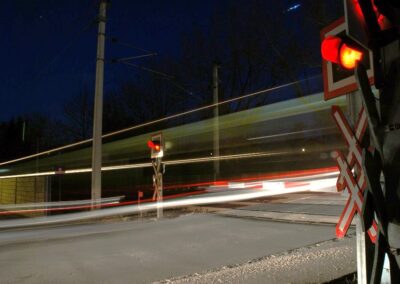
Switzerland risks isolation in international rail traffic
From 2024, Switzerland will lose access to the EU platform for harmonised approval procedures for new rolling stock. This is tantamount to a further step towards isolation in international rail transport. Unless European-Helvetic relations normalise.
This is what it’s all about:
- Access to “One Stop Shop” will only be extended until the end of 2023
- From then on, the EU will treat Switzerland as a third country.
- This jeopardises modal shift, digitalisation and automation
The decision of the joint committee on the land transport agreement with the EU on the fourth railway package has so far secured Switzerland access to the “One Stop Shop” (OSS) database of the European Railway Agency (ERA). OSS contains common simplified procedures for vehicle approvals and safety certificates in cross-border rail traffic. According to the FOT (cf. publication in german), this access will only be extended until the end of 2023.
This decision is due to the unresolved issues in the bilateral relationship between Switzerland and the EU. Separate procedures are expected to take effect from 2024. The same applies to the agreements on border operating routes.
It is urgently necessary for Switzerland to clearly declare its support for cooperation with the European states. Otherwise, both the modal shift and the digitalisation and automation of rail freight transport are at risk.
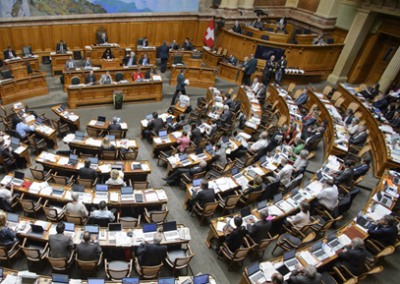
Winter session 2022
On 6 December 2022, the Council of States adopted two motions in the second instance. They are important for modal shift in transit, but also concern the Basel-North ports route, which is central for import and export traffic. We at the VAP support both motions and encourage the extension of state support to conventional rail freight transport.
This is what it’s all about:
- Council of States adopts two motions in favour of the freight corridor through Switzerland
- We at the VAP support the contents of the motions – and set priorities
- Because conventional rail freight transports are currently still being excluded
Promotion of the freight corridor through Switzerland
With the motion 22.3013 «Strengthening the attractiveness and competitiveness of the freight corridor through Switzerland», the Federal Council is to specifically extend the support measures in transit to certain regions and groups of goods. We at the VAP support this motion. However, it excludes conventional rail freight transport and its untapped potential. This deficiency should be corrected as soon as possible.
Article 8 of the Freight Traffic Shift Act (in german) allows the promotion of all – i.e. transalpine – freight traffic in transit. Accordingly, the Federal Council should be instructed to promote all freight traffic and to provide the promotion instruments consisting of financial support, quality monitoring and the expansion of access routes for conventional traffic as well. For these, too, the targeted extension of support measures to certain regions and freight groups makes sense. By sticking to the dogma of «combined transport», Switzerland is missing out on interesting opportunities for an additional shift from road to rail.
The Federal Council should design the support instruments in a technology-neutral way and extend them to all freight transport in transit, regardless of the type of production.
Expansion of the Wörth-Strasbourg Neat feeder road on the left bank of the Rhine
Motion 22.3000 «Continuation of the successful modal shift policy and guarantee of supply security thanks to expansion of the Wörth-Strasbourg corridor on the left bank of the Rhine» calls on the Federal Council to take care of the electrification and upgrading of the affected section of the line to NEAT standards. It is considering the possibility of funding from Switzerland.
We in the VAP support this motion, as we did with motion 20.3003 «State treaty for a Neat access route on the left bank of the Rhine». An efficient routing of the flat railway in the northern approach to the NRLA is urgently needed in terms of supply security, alternative capacity for construction phases, punctuality and quality. Electrification and the introduction of the NRLA standard on the affected section of track, together with the simultaneous expansion of the Kannenfeld and Schützenmatt tunnels to 4 metres, will allow an initial substantial increase in capacity on the northern approach to the NRLA.
Click here for the SDA news item of 6 December 2022 (in german)
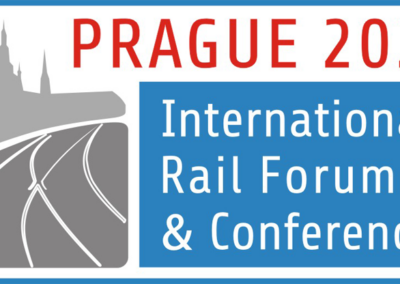
The rail sector must reinvent itself
Rail is not exactly famous for its willingness to innovate. This must and will change if it wants to remain sustainable as a transport mode. At the 7th International Railway Forum IRFC 2022, the experts presented a wide range of initiatives, innovations and reorganisations. We have summarised and critically appraised the most important ones here.
This is what it’s all about:
- Implementing the Green Deal requires innovation, new technologies and a comprehensive modernisation of the rail sector
- The scalability of innovations can only be achieved through cooperation and coordination.
- Switzerland must not miss the boat on EU innovation programmes
Under the Czech Presidency of the Council of the EU, the EU Minister of Transport hosted the IRFC in Prague from 5 to 7 October 2022. The motto of the congress was: “Building a new generation of railways together”. The Czech Minister of Transport, Martin Kupka, emphasised the key role of railways for the successful implementation of the Green Deal. With this, the EU has defined a clear answer to the advancing climate change. Traffic and transport in Europe are to become CO2-neutral by 2050. With the 2050 climate targets, the Federal Council is striving to replace fossil fuels in Switzerland within a comparable timeframe.
For a few years now, a paradigm shift has been taking place in the rail sector. Politicians are setting deadlines and issuing concrete mandates to the sectors. In order for the European railways to be able to react according to the mandates, more cooperation is needed in the further development of new technologies and their implementation. The technical pillar of the 4th railway package forms the basis for the creation of the planned unified European railway system.
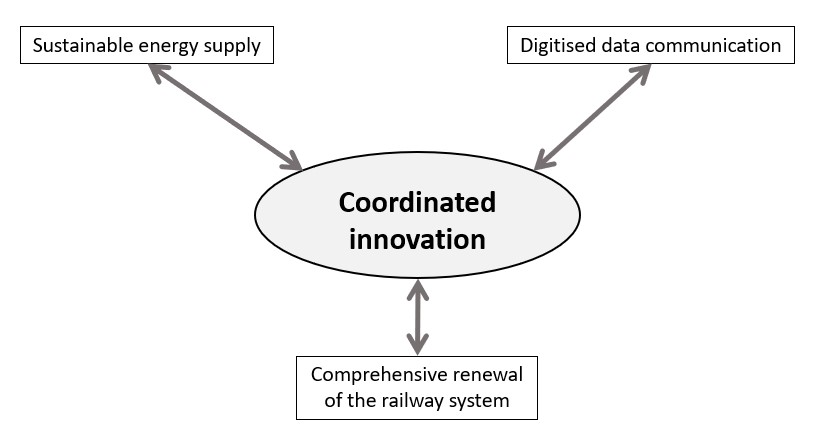
Until new technologies have reached their application maturity, it is first necessary to coordinate innovation (cf. figure) and to conduct targeted research to develop the scientific basis. To this end, the EU has built up efficient and competent organisations in recent years: The “Horizon” programme leads and finances various research projects. Thanks to cross-sectoral networking, the results and findings should be made available to a wide range of users in a timely manner. Within the framework of the innovation partnership Europe’s Rail Joint Undertaking (EU-Rail), innovative new approaches based on research results are given concrete form. The important projects for rail operations and technology are based on the two pillars “System Pillar” and “Technical Pillar”. The Railway Agency ERA defines the new uniform specifications for European railway applications and thus ensures interoperability. Thanks to this pooling of knowledge, solutions ready for international application can be developed in a short time.
Energy of the future is renewable
Until now, industrialised economies have mainly used fossil fuels. For a long time, these were available on the international market at low prices. With the Green Deal, the EU wants to reduce transport-related emissions by 90% by 2050 and shift 75% of the transport volume from road to rail or waterways. The important energy sources of the future are hydrogen and electricity, both produced from renewable resources.
Modern data communication is digital
Industrialised processes function successfully when the necessary data is directly and immediately available to all participants. The current use of data is still limited; for many sub-processes, the data is collected again and again. Such solo efforts are resource- and time-intensive as well as error-prone. In future, data should be available to all authorised participants without media discontinuity and in real time. Direct access to data is central to the realisation of automated processes, as is effective data protection. Cyber security is becoming the core issue of modern data communication.
Reorganisation of the railway system called for
Railways were essential to industrialisation in the 19th and early 20th centuries. It was not until the middle of the 20th century that road and air transport pushed back the railways in transport thanks to their successful innovative steps. The decisive factors were intramodal competition and rigorous customer orientation. The customers’ most important question was: How can we fulfil our needs more easily, more comfortably and more cheaply? And they received suitable answers on the road.
Today, the railways must finally ask themselves the same question. The railway is an efficient and resource-saving transport system with numerous advantages. In a direct comparison of the energy required, the electrified railway is the clear winner over the road. Under the same general conditions, the railway requires 10 times less energy than the road. Important European railway lines are already electrified, so that the required traction energy can be used with high efficiency. Today, a widely ramified network of lines connects the important regions of Europe, a large part of the lines are standard gauge, only in a few European regions are deviating gauges in operation today.
In order for the planned shift of traffic to the railways to actually be realised, a cultural change in the railways towards intramodal competition and customer orientation is first needed, as well as a comprehensive and systematic renewal of the railway system:
- TEN‑T: The EU has defined the trans-European rail network to connect all major European centres. Trains are to be able to run without obstacles on a uniform, harmonised infrastructure; on secondary lines, hydrogen or battery operation can ensure the desired CO2 neutrality. The expansion of the railway network is being carried out with two different emphases: For passenger transport, a high-speed network is to be built that connects the important centres and enables attractive travel times. For freight transport, the necessary train paths are to be made available so that rail freight transport can grow in accordance with the political requirements. The freight railways must more than double their transport capacity in the coming decades. They can only achieve this ambitious goal with the help of innovation. In addition, the corridor managers must be equipped with comprehensive competences so that the current cherry-picking of the national, integratedly managed state railways comes to an end.
- Interoperability and standardisation: The various European railway systems are still subject to a multitude of often different national regulations. Compliance with these still significantly restricts free cross-border rail traffic and enables unfair competitive advantages in the national market. Despite the technical specifications of interoperability (TSI), national regulations still massively hinder cross-border traffic. The EU has made the elimination of these national rules an important leadership task with the “rules cleaning-up programme”. This is a crucial programme of the technical pillar of the 4th EU railway package to create the Single European Railway Area (SERA). While the European Railway Agency (ERA) is responsible for the further development of the Technical Specifications for Interoperability (TSIs), the railway sector has to update and develop the related standards and norms. In the desired ideal case, the TSIs and the standards should sufficiently specify all railway subsystems in all participating European countries. Switzerland also relies consistently on the TSI in the standard gauge sector. It has adopted the first elements of the technical pillar of the 4th EU railway package within the framework of the current overland transport agreement. As the dialogue between the EU and Switzerland is currently at a standstill, the planned continuation is unfortunately not possible at present.
- Digital automatic coupling (DAK): The railways must replace their historically grown but outdated standards such as the classic screw coupling in favour of modern digitalised systems – such as the DAK4 – across the board. This forms a decisive basis for future comprehensive automation in the rail sector. Even more important, however, is the networking of all actors along the entire logistics chain – beyond the mere rail run – thanks to the possibilities of digitalisation. Freely accessible data and booking platforms open up unimagined increases in efficiency and quality. The members of the VAP and SBB are also actively contributing to the success of this important project with their know-how.
- Energy: In the field of energy, the necessary processes for the CO2-neutral production, distribution and simple use of hydrogen are being worked on. For operation on longer, non-electrified railway lines, hydrogen is a promising energy source that can quickly replace fossil fuels.
Marathon with hurdles
With the Green Deal, the EU has defined a comprehensive programme to create a CO2-neutral Europe. However, the member states have different starting points, priorities and interests. Consequently, the implementation of this ambitious programme will have to overcome a number of hurdles. It remains to be seen whether the national interests of the state railways can be sufficiently set aside in favour of a common European solution.
The railway is to play a key role in European passenger and freight transport in the future. It has some convincing advantages. But it must also overcome an aversion to renewal, change and competition that has developed over many decades. The compartmentalisation of markets, especially by the state railways, continues to be a major obstacle in many places. By sticking to national regulations, often under the pretext of safety considerations, state railways want to continue to protect themselves from unwanted international competition. It is up to the member states to help the European idea achieve a breakthrough and to put a stop to unfair practices by their state railways.
The rail sector must set new standards through innovation. It must standardise and streamline its regulatory environment internationally. When developing new systems, large suppliers to the rail sector must not try to gain a one-sided market advantage through exclusive, incompatible products. For sustainable migration success, the sector needs compatible, mature and reliable innovative products. The manufacturers have not exactly distinguished themselves in this respect in recent years.
Whether the intended shift of transport to rail will be feasible on the planned scale depends on the financial resources that can be deployed. There will be no bulging EU coffers for the migration from which the individual companies can help themselves as needed. The individual member states will have to contribute to the renewal and expansion of the railway infrastructure with substantial start-up financing. This also applies to Switzerland. Core projects such as the DAK must be internationally coordinated, otherwise their effect will fizzle out without a sound.
Switzerland is part of Europe
Switzerland, too, can only gain from active participation in these EU programmes. The Swiss standard gauge network with its major transit axes contributes to the trans-European rail network of the EU. It forms an important part of the uniform interoperable European system SERA. Since many of the Swiss transports are cross-border, interoperable solutions are indispensable. Switzerland has fulfilled its planned target with the continuous expansion of the north-south transversals as announced. The Swiss railway network must be further expanded for domestic traffic in order to be able to cope with the growth target in freight transport in the future. Our experts can actively make valuable contributions to development and compete with the best internationally. Our railway companies can strengthen their market position with new concepts, especially in import and export traffic.
The VAP supports joint activities to further develop the rail sector into an important partner in the multimodal transport system. In this context, cooperation at European level and intramodal competition is a crucial prerequisite to achieve the political goals on time. In terms of transport, we are so closely linked with neighbouring countries that our economy needs obstacle-free cross-border traffic and transport services. From an energy point of view, rail is predestined for longer distances. The political differences between Switzerland and the EU continue to hinder the urgently needed international cooperation. The railway industry is well advised to actively seek and cultivate professional exchange despite the hurdles. We can only have a successful railway future together.